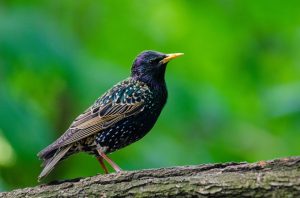Diminishing numbers of starlings in recent years make them a less frequent garden visitor. If you do have starlings, they may cause annoyance with their bullying tactics to frighten away the other garden birds.
This might lead you to wonder are starlings protected, and if there is any way they can be deterred from your land?
Starlings have been known to cause huge amounts of damage to open farmland, particularly through winter. As families split up post-breeding season, the juveniles flock together in their hundreds, sometimes thousands, and wreak havoc on dormant crops and depositing their droppings. When Continental starlings join their number, the problem only increases.

Their droppings are a haven for bacteria, and in warm and hot weather, produce fungal spores. Although this can threaten human health if in very close contact, it is unlikely that the birds can create enough in their short roosting time, to cause a major hazard.
More than anything, it is most unsightly, and sometimes smelly.
Starlings are protected under the Wildlife and Countryside Act (1981) and Wildlife (Northern Ireland) Order 1985.
Not that you would want to kill them, but doing so intentionally is prohibited and against the law. This also implies to injuring or taking a bird.
Their nests are also protected, it is illegal to damage, destroy, or take an active nest or any of its contents.
Table of Contents
Starlings – the Red Listed Species
The International Union for Conservation of Nature (IUCN) devised a set of criteria to assess the extinction risk of thousands of species of bird and animal.
A traffic light system is used to categorize the severity of decline and extinction probability.
RED – Denotes a globally threatened species that has declined in UK breeding population over the last 25 years and beyond. Numbers must have decreased by at least 50%
AMBER – Denotes a moderate decline of between 25 – 50% in the last 25 years and beyond,with an adverse status within Europe. They are rare breeders with only 1-300 breeding pairs in the UK.
GREEN – The least critical concern, numbers are stable and they are regularly sighted within the UK.
Starlings are in crisis as they fall into the red category.
Can You Get Rid of Starlings?
Their nests might be protected, but their roosts aren’t, so there is no law in place stopping you from trying to frighten the starlings away to prevent them from roosting.
There are multiple safe methods, some are electronic devices that light or make sound at such a frequency that the birds will fly away. However, this also implies to all of the other birds.
Safer methods utilise shiny metals and decoy birds of prey, the natural predators of starlings.

Cutting back trees, bushes, and vegetation provides less roosting opportunities, and is a viable option if the problem persists.
Sadly, this will also remove the habitat and food source of many other bird species and wildlife.
Final thought…
Unless starlings are posing a serious risk to your health or livelihood, it is probably unnecessary to lose the greenery in your garden to keep them away.
Try other scare methods to prevent them from roosting, but that is as far as you can take it.
Are starlings protected? Indeed they are, so we should try and be more tolerant of them to prevent losing this species forever.

If starlings have been protected under a 1981 act why are they still considered endangered (and still protected 40 year’s later?
Because their numbers are still in decline and have not increased, this is the same across Europe
Why are starlings protected if they are a big problem?
Because their numbers have been declining sharply in the UK since the 1970s